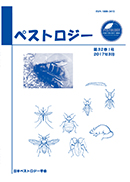Volume 30, Issue 1
Displaying 1-6 of 6 articles from this issue
- |<
- <
- 1
- >
- >|
Original Articles
-
2015 Volume 30 Issue 1 Pages 1-5
Published: May 25, 2015
Released on J-STAGE: April 10, 2019
Download PDF (367K) -
2015 Volume 30 Issue 1 Pages 7-12
Published: May 25, 2015
Released on J-STAGE: April 10, 2019
Download PDF (3637K) -
2015 Volume 30 Issue 1 Pages 13-18
Published: May 25, 2015
Released on J-STAGE: April 10, 2019
Download PDF (1595K)
Short Communication
-
2015 Volume 30 Issue 1 Pages 19-22
Published: May 25, 2015
Released on J-STAGE: April 10, 2019
Download PDF (547K)
Technical Notes
-
2015 Volume 30 Issue 1 Pages 23-24
Published: May 25, 2015
Released on J-STAGE: April 10, 2019
Download PDF (109K) -
2015 Volume 30 Issue 1 Pages 25-29
Published: May 25, 2015
Released on J-STAGE: April 10, 2019
Download PDF (18113K)
- |<
- <
- 1
- >
- >|
